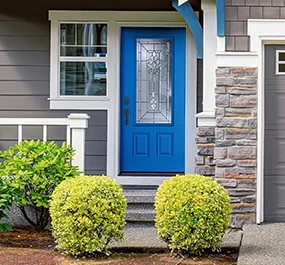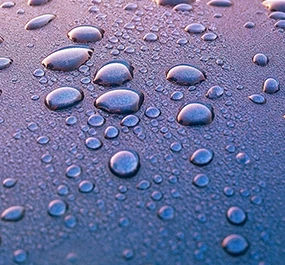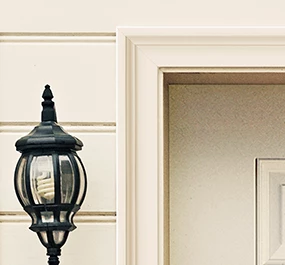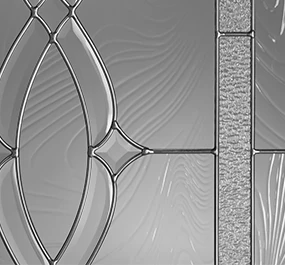There’s a lot more to doors than what meets the eye, and it’s just as important to consider the material inside the door as the material on the outside. The door core is an essential part of the door, and different door cores offer a variety of benefits, from structural stability, to performance, to durability, to value. It’s important to choose a door core that’s right for your specific needs.
Different door materials—like wood, fiberglass, and steel—also have different core options available. We’ll cover the most common door cores for each of these exterior door types. For a comprehensive comparison of these door materials, see our wood vs. fiberglass vs. steel doors guide.
Door cores for wood doors
Wood doors, one of the classic exterior door options, do not offer much variety when it comes to exterior door cores. There are two common types of cores for exterior wood doors—solid wood and solid core.
Solid Wood
Solid wood exterior doors have been the traditional choice for years as they are 100% natural wood. While these doors offer great insulation and soundproofing, and are aesthetically pleasing, they require quite a bit of proper care to ensure the door lasts. As wood is susceptible to warping, it’s important to make sure they’re being regularly maintained.
Solid Core
Similar to solid wood, solid core wood doors offer excellent insulation and soundproofing, but are generally a more affordable option. Solid core wood doors start with a wood or veneer door skin, but inside a hollow core is left to be filled with wood composite materials. Doors with solid cores are often heavier than solid wood doors, which can provide a boost in security, but they are prone to shrinking or expanding when exposed to moisture and temperature changes, which also means extra maintenance.
There are a variety of solid core options, with particleboard cores and stave cores being the most common. Particleboard is composed of wood particles adhered together to form a solid material. It’s one of the most popular door core options for wood doors due to well-rounded performance, affordability, and availability. Stave cores feature blocks of wood—also referred to as staves—which are glued together. Stave core doors offer strength and durability, but are often lighter than particleboard.
Door cores for steel doors
Another popular material for exterior doors is steel. Steel is a common choice when security is a top priority, but the security and energy efficiency of a steel door is very dependent on the type of door core. There are two most common types of door cores for exterior steel doors. However, it is important to note that even with the best core, a steel door’s exterior will still be prone to dents, rust, and scratches that may necessitate a full replacement.
Polystyrene
Polystyrene door cores (also referred to as EPS cores) are one of the most common choices for homeowners looking for benefits like added insulation. Polystyrene acts as a thermal barrier, making it a good choice for cutting down on heating costs during the winter. The insulation also helps with soundproofing. One downside—polystyrene cores are mostly drop-in cores, meaning that this core does not adhere and chemically bond to the door skin, resulting in poor structural support, and leaves gaps and air pockets between the door skins and door core. This leaves more room for damaging condensation to build up inside the door.
Polyurethane
Polyurethane is somewhat similar to polystyrene, but it offers more quality in terms of insulation, soundproofing, and structural support to doors, making it a slightly more expensive option. Polyurethane is generally more dense and will adhere and bite onto the door skins, providing a nearly airtight fit. The quality of a polyurethane door core depends on the density, but these are typically a better choice for exterior doors when it comes to insulation, security, and soundproofing.
Door cores for fiberglass doors
Fiberglass exterior doors feature the same most common cores as steel exterior doors. In addition to polyurethane, the second most common fiberglass door core is polystyrene, which offers a lower price point with good insulation. However, like steel, high-density, polyurethane foam cores maximize door performance in fiberglass exterior doors.
As mentioned earlier, polyurethane door cores come in varying density levels, meaning not all are created equal—it’s best to look for high-density options. These tightly packed cores provide superior insulation, which maximizes energy efficiency and soundproofing capabilities. Again, densely packed foam means fewer air gaps are left within the door, preventing moisture (and mold and mildew) from building up inside the door. When combined with a fiberglass skin’s durability and performance, fiberglass doors with high-density, polyurethane door cores are an excellent option.
While other fiberglass doors offer polyurethane core options, Plastpro’s high-density, polyurethane foam door core is a superior choice. Plastpro’s exterior doors are filled with CFC-free, high-density, polyurethane foam with composite material protecting it on all six sides. These door cores offer six times the insulating value as a wood door. The high-density foam also adds rigidity and structural support to the doors, making them a great choice to improve front door security.
It should also be noted that in addition to the most common cores covered, there are other exterior door cores that serve specific functions—such as mineral cores, which are fairly common in fire-rated or soundproof doors. Other specialized doors may feature unique internal properties, so it is important to get a detailed breakdown of your door materials—door core included—to ensure the door fits your individual needs.
Check out Plastpro’s Where to Buy page to find the closest distributor for fiberglass doors. For more information on our fiberglass door offerings, visit our website.



